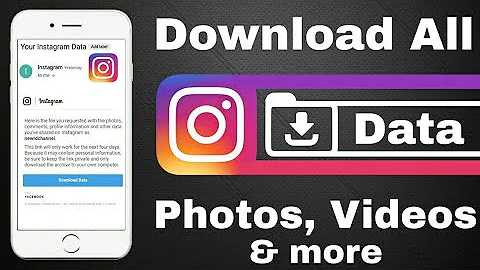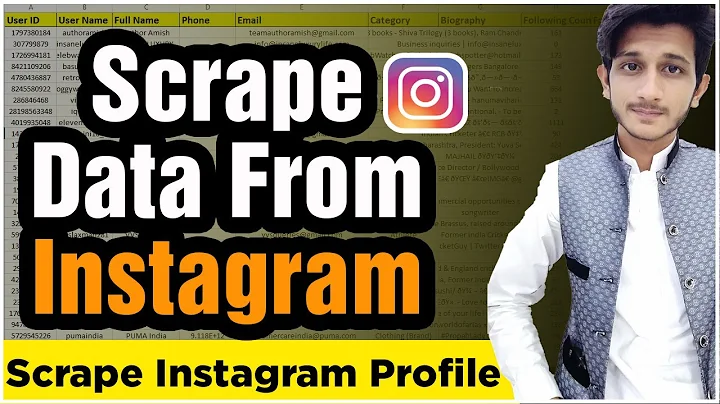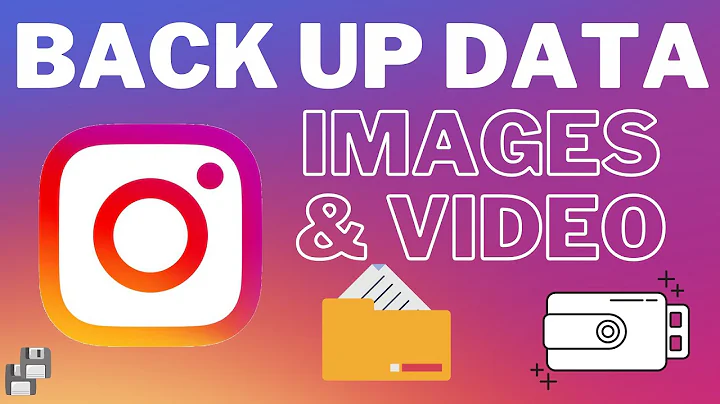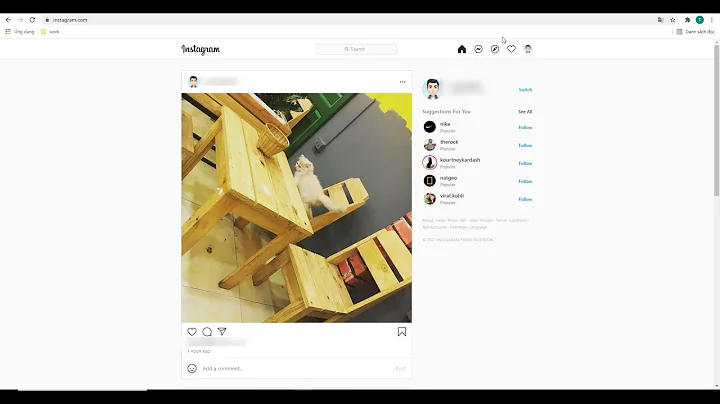How to get Instagram data from a user on Android?
Solution 1
I used the below code for Instagram user authentication process, here is share my code. Hope it will help to you,
InstagramApp.java
package br.com.dina.oauth.instagram;
import java.io.BufferedReader;
import java.io.IOException;
import java.io.InputStream;
import java.io.InputStreamReader;
import java.io.OutputStreamWriter;
import java.net.HttpURLConnection;
import java.net.URL;
import org.json.JSONObject;
import org.json.JSONTokener;
import android.app.ProgressDialog;
import android.content.Context;
import android.content.Intent;
import android.net.Uri;
import android.os.Handler;
import android.os.Message;
import android.util.Log;
import br.com.dina.oauth.instagram.InstagramDialog.OAuthDialogListener;
/**
*
* @author Thiago Locatelli <[email protected]>
* @author Lorensius W. L T <[email protected]>
*
*/
public class InstagramApp {
private InstagramSession mSession;
private InstagramDialog mDialog;
private OAuthAuthenticationListener mListener;
private ProgressDialog mProgress;
private String mAuthUrl;
private String mTokenUrl;
private String mAccessToken;
private Context mCtx;
private String mClientId;
private String mClientSecret;
private static int WHAT_FINALIZE = 0;
private static int WHAT_ERROR = 1;
private static int WHAT_FETCH_INFO = 2;
/**
* Callback url, as set in 'Manage OAuth Costumers' page
* (https://developer.github.com/)
*/
public static String mCallbackUrl = "";
private static final String AUTH_URL = "https://api.instagram.com/oauth/authorize/";
private static final String TOKEN_URL = "https://api.instagram.com/oauth/access_token";
private static final String API_URL = "https://api.instagram.com/v1";
private static final String TAG = "InstagramAPI";
public InstagramApp(Context context, String clientId, String clientSecret,
String callbackUrl) {
mClientId = clientId;
mClientSecret = clientSecret;
mCtx = context;
mSession = new InstagramSession(context);
mAccessToken = mSession.getAccessToken();
mCallbackUrl = callbackUrl;
mTokenUrl = TOKEN_URL + "?client_id=" + clientId + "&client_secret="
+ clientSecret + "&redirect_uri=" + mCallbackUrl
+ "&grant_type=authorization_code";
mAuthUrl = AUTH_URL
+ "?client_id="
+ clientId
+ "&redirect_uri="
+ mCallbackUrl
+ "&response_type=code&display=touch&scope=likes+comments+relationships";
OAuthDialogListener listener = new OAuthDialogListener() {
@Override
public void onComplete(String code) {
getAccessToken(code);
}
@Override
public void onError(String error) {
mListener.onFail("Authorization failed");
}
};
mDialog = new InstagramDialog(context, mAuthUrl, listener);
mProgress = new ProgressDialog(context);
mProgress.setCancelable(false);
}
private void getAccessToken(final String code) {
mProgress.setMessage("Getting access token ...");
mProgress.show();
new Thread() {
@Override
public void run() {
Log.i(TAG, "Getting access token");
int what = WHAT_FETCH_INFO;
try {
URL url = new URL(TOKEN_URL);
// URL url = new URL(mTokenUrl + "&code=" + code);
Log.i(TAG, "Opening Token URL " + url.toString());
HttpURLConnection urlConnection = (HttpURLConnection) url
.openConnection();
urlConnection.setRequestMethod("POST");
urlConnection.setDoInput(true);
urlConnection.setDoOutput(true);
// urlConnection.connect();
OutputStreamWriter writer = new OutputStreamWriter(
urlConnection.getOutputStream());
writer.write("client_id=" + mClientId + "&client_secret="
+ mClientSecret + "&grant_type=authorization_code"
+ "&redirect_uri=" + mCallbackUrl + "&code=" + code);
writer.flush();
String response = streamToString(urlConnection
.getInputStream());
Log.i(TAG, "response " + response);
JSONObject jsonObj = (JSONObject) new JSONTokener(response)
.nextValue();
mAccessToken = jsonObj.getString("access_token");
// Log.i(TAG, "Got access token: " + mAccessToken);
String id = jsonObj.getJSONObject("user").getString("id");
String user = jsonObj.getJSONObject("user").getString(
"username");
String name = jsonObj.getJSONObject("user").getString(
"full_name");
String userImage = jsonObj.getJSONObject("user").getString(
"profile_picture");
mSession.storeAccessToken(mAccessToken, id, user, name,
userImage);
} catch (Exception ex) {
what = WHAT_ERROR;
ex.printStackTrace();
}
mHandler.sendMessage(mHandler.obtainMessage(what, 1, 0));
}
}.start();
}
private void fetchUserName() {
mProgress.setMessage("Finalizing ...");
new Thread() {
@Override
public void run() {
Log.i(TAG, "Fetching user info");
int what = WHAT_FINALIZE;
try {
URL url = new URL(API_URL + "/users/" + mSession.getId()
+ "/?access_token=" + mAccessToken);
Log.d(TAG, "Opening URL " + url.toString());
HttpURLConnection urlConnection = (HttpURLConnection) url
.openConnection();
urlConnection.setRequestMethod("GET");
urlConnection.setDoInput(true);
urlConnection.setDoOutput(true);
urlConnection.connect();
String response = streamToString(urlConnection
.getInputStream());
System.out.println(response);
JSONObject jsonObj = (JSONObject) new JSONTokener(response)
.nextValue();
String name = jsonObj.getJSONObject("data").getString(
"full_name");
// String bio =
// jsonObj.getJSONObject("data").getString("bio");
Log.i(TAG, "Got name: " + name);
} catch (Exception ex) {
what = WHAT_ERROR;
ex.printStackTrace();
}
mHandler.sendMessage(mHandler.obtainMessage(what, 2, 0));
}
}.start();
}
private Handler mHandler = new Handler() {
@Override
public void handleMessage(Message msg) {
if (msg.what == WHAT_ERROR) {
mProgress.dismiss();
if (msg.arg1 == 1) {
mListener.onFail("Failed to get access token");
} else if (msg.arg1 == 2) {
mListener.onFail("Failed to get user information");
}
} else if (msg.what == WHAT_FETCH_INFO) {
mProgress.dismiss();
mListener.onSuccess();
// fetchUserName();
} else {
// mProgress.dismiss();
// mListener.onSuccess();
}
}
};
public boolean hasAccessToken() {
return (mAccessToken == null) ? false : true;
}
public void setListener(OAuthAuthenticationListener listener) {
mListener = listener;
}
// getting username
public String getUserName() {
return mSession.getUsername();
}
// getting user id
public String getId() {
return mSession.getId();
}
// getting username
public String getName() {
return mSession.getName();
}
// getting user image
public String getUserPicture() {
return mSession.getUserImage();
}
// getting accesstoken
public String getAccessToken() {
return mSession.getAccessToken();
}
public void authorize() {
// Intent webAuthIntent = new Intent(Intent.ACTION_VIEW);
// webAuthIntent.setData(Uri.parse(AUTH_URL));
// mCtx.startActivity(webAuthIntent);
mDialog.show();
}
private String streamToString(InputStream is) throws IOException {
String str = "";
if (is != null) {
StringBuilder sb = new StringBuilder();
String line;
try {
BufferedReader reader = new BufferedReader(
new InputStreamReader(is));
while ((line = reader.readLine()) != null) {
sb.append(line);
}
reader.close();
} finally {
is.close();
}
str = sb.toString();
}
return str;
}
public void resetAccessToken() {
if (mAccessToken != null) {
mSession.resetAccessToken();
mAccessToken = null;
}
}
public interface OAuthAuthenticationListener {
public abstract void onSuccess();
public abstract void onFail(String error);
}
}
InstagramDialog.java
package br.com.dina.oauth.instagram;
import android.app.Dialog;
import android.app.ProgressDialog;
import android.content.Context;
import android.graphics.Bitmap;
import android.graphics.Color;
import android.graphics.Typeface;
import android.os.Bundle;
import android.util.Log;
import android.view.Display;
import android.view.ViewGroup;
import android.view.Window;
import android.webkit.CookieManager;
import android.webkit.CookieSyncManager;
import android.webkit.WebView;
import android.webkit.WebViewClient;
import android.widget.FrameLayout;
import android.widget.LinearLayout;
import android.widget.TextView;
/**
* Display 37Signals authentication dialog.
*
* @author Thiago Locatelli <[email protected]>
* @author Lorensius W. L T <[email protected]>
*
*/
public class InstagramDialog extends Dialog {
static final float[] DIMENSIONS_LANDSCAPE = { 460, 260 };
static final float[] DIMENSIONS_PORTRAIT = { 420, 420 };
static final FrameLayout.LayoutParams FILL = new FrameLayout.LayoutParams(
ViewGroup.LayoutParams.WRAP_CONTENT,
ViewGroup.LayoutParams.WRAP_CONTENT);
static final int MARGIN = 4;
static final int PADDING = 2;
private String mUrl;
private OAuthDialogListener mListener;
private ProgressDialog mSpinner;
private WebView mWebView;
private LinearLayout mContent;
private TextView mTitle;
private static final String TAG = "Instagram-WebView";
public InstagramDialog(Context context, String url,
OAuthDialogListener listener) {
super(context);
mUrl = url;
mListener = listener;
}
@Override
protected void onCreate(Bundle savedInstanceState) {
super.onCreate(savedInstanceState);
mSpinner = new ProgressDialog(getContext());
mSpinner.requestWindowFeature(Window.FEATURE_NO_TITLE);
mSpinner.setMessage("Loading...");
mContent = new LinearLayout(getContext());
mContent.setOrientation(LinearLayout.VERTICAL);
setUpTitle();
setUpWebView();
Display display = getWindow().getWindowManager().getDefaultDisplay();
final float scale = getContext().getResources().getDisplayMetrics().density;
float[] dimensions = (display.getWidth() < display.getHeight()) ? DIMENSIONS_PORTRAIT
: DIMENSIONS_LANDSCAPE;
addContentView(mContent, new FrameLayout.LayoutParams(
(int) (dimensions[0] * scale + 0.5f), (int) (dimensions[1]
* scale + 0.5f)));
CookieSyncManager.createInstance(getContext());
CookieManager cookieManager = CookieManager.getInstance();
cookieManager.removeAllCookie();
}
private void setUpTitle() {
requestWindowFeature(Window.FEATURE_NO_TITLE);
mTitle = new TextView(getContext());
mTitle.setText("Instagram");
mTitle.setTextColor(Color.WHITE);
mTitle.setTypeface(Typeface.DEFAULT_BOLD);
mTitle.setBackgroundColor(Color.BLACK);
mTitle.setPadding(MARGIN + PADDING, MARGIN, MARGIN, MARGIN);
mContent.addView(mTitle);
}
private void setUpWebView() {
mWebView = new WebView(getContext());
mWebView.setVerticalScrollBarEnabled(false);
mWebView.setHorizontalScrollBarEnabled(false);
mWebView.setWebViewClient(new OAuthWebViewClient());
mWebView.getSettings().setJavaScriptEnabled(true);
mWebView.loadUrl(mUrl);
mWebView.setLayoutParams(FILL);
mContent.addView(mWebView);
}
private class OAuthWebViewClient extends WebViewClient {
@Override
public boolean shouldOverrideUrlLoading(WebView view, String url) {
Log.d(TAG, "Redirecting URL " + url);
if (url.startsWith(InstagramApp.mCallbackUrl)) {
String urls[] = url.split("=");
mListener.onComplete(urls[1]);
InstagramDialog.this.dismiss();
return true;
}
return false;
}
@Override
public void onReceivedError(WebView view, int errorCode,
String description, String failingUrl) {
Log.d(TAG, "Page error: " + description);
super.onReceivedError(view, errorCode, description, failingUrl);
mListener.onError(description);
InstagramDialog.this.dismiss();
}
@Override
public void onPageStarted(WebView view, String url, Bitmap favicon) {
Log.d(TAG, "Loading URL: " + url);
super.onPageStarted(view, url, favicon);
mSpinner.show();
}
@Override
public void onPageFinished(WebView view, String url) {
super.onPageFinished(view, url);
String title = mWebView.getTitle();
if (title != null && title.length() > 0) {
mTitle.setText(title);
}
Log.d(TAG, "onPageFinished URL: " + url);
mSpinner.dismiss();
}
}
public interface OAuthDialogListener {
public abstract void onComplete(String accessToken);
public abstract void onError(String error);
}
}
InstagramSession.java
package br.com.dina.oauth.instagram;
import android.content.Context;
import android.content.SharedPreferences;
import android.content.SharedPreferences.Editor;
/**
* Manage access token and user name. Uses shared preferences to store access
* token and user name.
*
* @author Thiago Locatelli <[email protected]>
* @author Lorensius W. L T <[email protected]>
*
*/
public class InstagramSession {
private SharedPreferences sharedPref;
private Editor editor;
private static final String SHARED = "Instagram_Preferences";
private static final String API_USERNAME = "username";
private static final String API_ID = "id";
private static final String API_NAME = "name";
private static final String API_ACCESS_TOKEN = "access_token";
private static final String API_USER_IMAGE = "user_image";
public InstagramSession(Context context) {
sharedPref = context.getSharedPreferences(SHARED, Context.MODE_PRIVATE);
editor = sharedPref.edit();
}
/**
*
* @param accessToken
* @param expireToken
* @param expiresIn
* @param username
*/
public void storeAccessToken(String accessToken, String id,
String username, String name, String image) {
editor.putString(API_ID, id);
editor.putString(API_NAME, name);
editor.putString(API_ACCESS_TOKEN, accessToken);
editor.putString(API_USERNAME, username);
editor.putString(API_USER_IMAGE, image);
editor.commit();
}
public void storeAccessToken(String accessToken) {
editor.putString(API_ACCESS_TOKEN, accessToken);
editor.commit();
}
/**
* Reset access token and user name
*/
public void resetAccessToken() {
editor.putString(API_ID, null);
editor.putString(API_NAME, null);
editor.putString(API_ACCESS_TOKEN, null);
editor.putString(API_USERNAME, null);
editor.putString(API_USER_IMAGE, null);
editor.commit();
}
/**
* Get user name
*
* @return User name
*/
public String getUsername() {
return sharedPref.getString(API_USERNAME, null);
}
/**
*
* @return
*/
public String getId() {
return sharedPref.getString(API_ID, null);
}
/**
*
* @return
*/
public String getName() {
return sharedPref.getString(API_NAME, null);
}
/**
* Get access token
*
* @return Access token
*/
public String getAccessToken() {
return sharedPref.getString(API_ACCESS_TOKEN, null);
}
/**
* Get userImage
*
* @return userImage
*/
public String getUserImage() {
return sharedPref.getString(API_USER_IMAGE, null);
}
}
The above three classes are static one and i say my thanks to the author, in InstagramApp.java class i little bit modified the getter setter methods to get all user values, and in MainActivity.java i used the below code.
private InstagramApp instaObj;
public static final String CLIENT_ID = "Your_ID";
public static final String CLIENT_SECRET = "Your_Sec_Key";
public static final String CALLBACK_URL = "Your_call_back_URL";
// Instagram Implementation
instaObj = new InstagramApp(this, CLIENT_ID,
CLIENT_SECRET, CALLBACK_URL);
instaObj.setListener(listener);
instaObj.authorize(); //add this in your button click or wherever you need to call the instagram api
OAuthAuthenticationListener listener = new OAuthAuthenticationListener() {
@Override
public void onSuccess() {
Log.e("Userid", instaObj.getId());
Log.e("Name", instaObj.getName());
Log.e("UserName", instaObj.getUserName());
}
@Override
public void onFail(String error) {
Toast.makeText(LoginPageActivity.this, error, Toast.LENGTH_SHORT)
.show();
}
};
Solution 2
Your InstagramApp.java
Just replace it with your current class in library.
package br.com.dina.oauth.instagram;
import java.io.BufferedReader;
import java.io.IOException;
import java.io.InputStream;
import java.io.InputStreamReader;
import java.io.OutputStreamWriter;
import java.net.HttpURLConnection;
import java.net.URL;
import org.json.JSONObject;
import org.json.JSONTokener;
import android.app.ProgressDialog;
import android.content.Context;
import android.content.Intent;
import android.net.Uri;
import android.os.Handler;
import android.os.Message;
import android.util.Log;
import br.com.dina.oauth.instagram.InstagramDialog.OAuthDialogListener;
/**
*
* @author Thiago Locatelli <[email protected]>
* @author Lorensius W. L T <[email protected]>
*
*/
public class InstagramApp {
private InstagramSession mSession;
private InstagramDialog mDialog;
private OAuthAuthenticationListener mListener;
private ProgressDialog mProgress;
private String mAuthUrl;
private String mTokenUrl;
private String mAccessToken;
private Context mCtx;
private String mClientId;
private String mClientSecret;
private static int WHAT_FINALIZE = 0;
private static int WHAT_ERROR = 1;
private static int WHAT_FETCH_INFO = 2;
/**
* Callback url, as set in 'Manage OAuth Costumers' page
* (https://developer.github.com/)
*/
public static String mCallbackUrl = "";
private static final String AUTH_URL = "https://api.instagram.com/oauth/authorize/";
private static final String TOKEN_URL = "https://api.instagram.com/oauth/access_token";
private static final String API_URL = "https://api.instagram.com/v1";
private static final String TAG = "InstagramAPI";
public InstagramApp(Context context, String clientId, String clientSecret,
String callbackUrl) {
mClientId = clientId;
mClientSecret = clientSecret;
mCtx = context;
mSession = new InstagramSession(context);
mAccessToken = mSession.getAccessToken();
mCallbackUrl = callbackUrl;
mTokenUrl = TOKEN_URL + "?client_id=" + clientId + "&client_secret="
+ clientSecret + "&redirect_uri=" + mCallbackUrl + "&grant_type=authorization_code";
mAuthUrl = AUTH_URL + "?client_id=" + clientId + "&redirect_uri="
+ mCallbackUrl + "&response_type=code&display=touch&scope=likes+comments+relationships";
OAuthDialogListener listener = new OAuthDialogListener() {
@Override
public void onComplete(String code) {
getAccessToken(code);
}
@Override
public void onError(String error) {
mListener.onFail("Authorization failed");
}
};
mDialog = new InstagramDialog(context, mAuthUrl, listener);
mProgress = new ProgressDialog(context);
mProgress.setCancelable(false);
}
private void getAccessToken(final String code) {
mProgress.setMessage("Getting access token ...");
mProgress.show();
new Thread() {
@Override
public void run() {
Log.i(TAG, "Getting access token");
int what = WHAT_FETCH_INFO;
try {
URL url = new URL(TOKEN_URL);
//URL url = new URL(mTokenUrl + "&code=" + code);
Log.i(TAG, "Opening Token URL " + url.toString());
HttpURLConnection urlConnection = (HttpURLConnection) url.openConnection();
urlConnection.setRequestMethod("POST");
urlConnection.setDoInput(true);
urlConnection.setDoOutput(true);
//urlConnection.connect();
OutputStreamWriter writer = new OutputStreamWriter(urlConnection.getOutputStream());
writer.write("client_id="+mClientId+
"&client_secret="+mClientSecret+
"&grant_type=authorization_code" +
"&redirect_uri="+mCallbackUrl+
"&code=" + code);
writer.flush();
String response = streamToString(urlConnection.getInputStream());
Log.i(TAG, "response " + response);
JSONObject jsonObj = (JSONObject) new JSONTokener(response).nextValue();
mAccessToken = jsonObj.getString("access_token");
Log.i(TAG, "Got access token: " + mAccessToken);
String id = jsonObj.getJSONObject("user").getString("id");
String user = jsonObj.getJSONObject("user").getString("username");
String name = jsonObj.getJSONObject("user").getString("full_name");
mSession.storeAccessToken(mAccessToken, id, user, name);
} catch (Exception ex) {
what = WHAT_ERROR;
ex.printStackTrace();
}
mHandler.sendMessage(mHandler.obtainMessage(what, 1, 0));
}
}.start();
}
private void fetchUserName() {
mProgress.setMessage("Finalizing ...");
new Thread() {
@Override
public void run() {
Log.i(TAG, "Fetching user info");
int what = WHAT_FINALIZE;
try {
URL url = new URL(API_URL + "/users/" + mSession.getId() + "/?access_token=" + mAccessToken);
Log.d(TAG, "Opening URL " + url.toString());
HttpURLConnection urlConnection = (HttpURLConnection) url.openConnection();
urlConnection.setRequestMethod("GET");
urlConnection.setDoInput(true);
//urlConnection.setDoOutput(true);
urlConnection.connect();
String response = streamToString(urlConnection.getInputStream());
System.out.println(response);
JSONObject jsonObj = (JSONObject) new JSONTokener(response).nextValue();
String name = jsonObj.getJSONObject("data").getString("full_name");
String bio = jsonObj.getJSONObject("data").getString("bio");
Log.i(TAG, "Got name: " + name + ", bio [" + bio + "]");
} catch (Exception ex) {
what = WHAT_ERROR;
ex.printStackTrace();
}
mHandler.sendMessage(mHandler.obtainMessage(what, 2, 0));
}
}.start();
}
private Handler mHandler = new Handler() {
@Override
public void handleMessage(Message msg) {
if (msg.what == WHAT_ERROR) {
mProgress.dismiss();
if(msg.arg1 == 1) {
mListener.onFail("Failed to get access token");
}
else if(msg.arg1 == 2) {
mListener.onFail("Failed to get user information");
}
}
else if(msg.what == WHAT_FETCH_INFO) {
fetchUserName();
}
else {
mProgress.dismiss();
mListener.onSuccess();
}
}
};
public boolean hasAccessToken() {
return (mAccessToken == null) ? false : true;
}
public void setListener(OAuthAuthenticationListener listener) {
mListener = listener;
}
public String getUserName() {
return mSession.getUsername();
}
public String getId() {
return mSession.getId();
}
public String getName() {
return mSession.getName();
}
public void authorize() {
//Intent webAuthIntent = new Intent(Intent.ACTION_VIEW);
//webAuthIntent.setData(Uri.parse(AUTH_URL));
//mCtx.startActivity(webAuthIntent);
mDialog.show();
}
private String streamToString(InputStream is) throws IOException {
String str = "";
if (is != null) {
StringBuilder sb = new StringBuilder();
String line;
try {
BufferedReader reader = new BufferedReader(
new InputStreamReader(is));
while ((line = reader.readLine()) != null) {
sb.append(line);
}
reader.close();
} finally {
is.close();
}
str = sb.toString();
}
return str;
}
public void resetAccessToken() {
if (mAccessToken != null) {
mSession.resetAccessToken();
mAccessToken = null;
}
}
public interface OAuthAuthenticationListener {
public abstract void onSuccess();
public abstract void onFail(String error);
}
}
Related videos on Youtube
Daniel Nazareth
Updated on September 15, 2022Comments
-
 Daniel Nazareth over 1 year
Daniel Nazareth over 1 yearI'm trying to fetch user data from Instagram in a Android application, because I need to get user photos and show in a gallery, but I'm having a problem to fetch user data.
Here is the code:
private void fetchUserName() { mProgress.setMessage("Finalizing ..."); new Thread() { @Override public void run() { Log.i(TAG, "Fetching user info"); int what = WHAT_FINALIZE; try { URL url = new URL(API_URL + "/users/" + mSession.getId() + "/media/recent/?access_token=" + mAccessToken); Log.d(TAG, "Opening URL " + url.toString()); HttpURLConnection urlConnection = (HttpURLConnection) url.openConnection(); urlConnection.setRequestMethod("GET"); urlConnection.setDoInput(true); urlConnection.setDoOutput(true); urlConnection.connect(); String response = streamToString(urlConnection.getInputStream()); JSONObject jsonObj = (JSONObject) new JSONTokener(response).nextValue(); String name = jsonObj.getJSONObject("data").getString("full_name"); String bio = jsonObj.getJSONObject("data").getString("bio"); Log.i(TAG, "Got name: " + name + ", bio [" + bio + "]"); } catch (Exception ex) { what = WHAT_ERROR; ex.printStackTrace(); } mHandler.sendMessage(mHandler.obtainMessage(what, 2, 0)); } }.start(); }But in this part is going to catch.
String response = streamToString(urlConnection.getInputStream());And I tried many ways to do JSON parse, but always give error when try to connect to url, like it:
HttpResponse httpResponse = httpClient.execute(httpPost);The url logged is :
And the error is:
11-29 14:31:45.300: W/System.err(11916): java.io.FileNotFoundException: https://api.instagram.com/v1/users/699022341/?access_token=699022341.aef690f.1888e66fed5d4764aeae1c121faa14fb 11-29 14:31:45.300: W/System.err(11916): at com.android.okhttp.internal.http.HttpURLConnectionImpl.getInputStream(HttpURLConnectionImpl.java:186) 11-29 14:31:45.300: W/System.err(11916): at com.android.okhttp.internal.http.HttpsURLConnectionImpl.getInputStream(HttpsURLConnectionImpl.java:246)I'm doing something wrong or need a Instagram permission, or something like that?
-
Aerrow over 10 years@Daniel Nazareth: is my answer is helpful for you?
-
 Daniel Nazareth over 10 yearsThanks man, it was useful to correct some errors! The error that was in fetchUserName() class was my bigger trouble, solve it commenting the urlConnection.setDoOutput(true); line
Daniel Nazareth over 10 yearsThanks man, it was useful to correct some errors! The error that was in fetchUserName() class was my bigger trouble, solve it commenting the urlConnection.setDoOutput(true); line -
Aerrow over 10 years@DanielNazareth: Nice, happy coding.. :)
-
Hummer about 10 yearsOnce you authorize the user and while getting the access token its giving me an error @Aerrow
-
Aerrow about 10 years@Hummer: Could you plz post the exact error, which you faced
-
Hummer about 10 yearsInstagramApp$1.handleMessage(InstagramApp.java:186) and this is pointing to mListener.onSuccess(); in Handler()
-
xsorifc28 over 9 yearsIs it safe to store the client & secret key in the code? Just wondering what happens if someone decompiles the apk an accesses the keys. I'd like to know if this is the best practice.
-
 Jatin over 9 yearsHey, I am using this code but problem is when i call it first time it showing me blank white screen. Can you help me how can i avoid this.
Jatin over 9 yearsHey, I am using this code but problem is when i call it first time it showing me blank white screen. Can you help me how can i avoid this.










